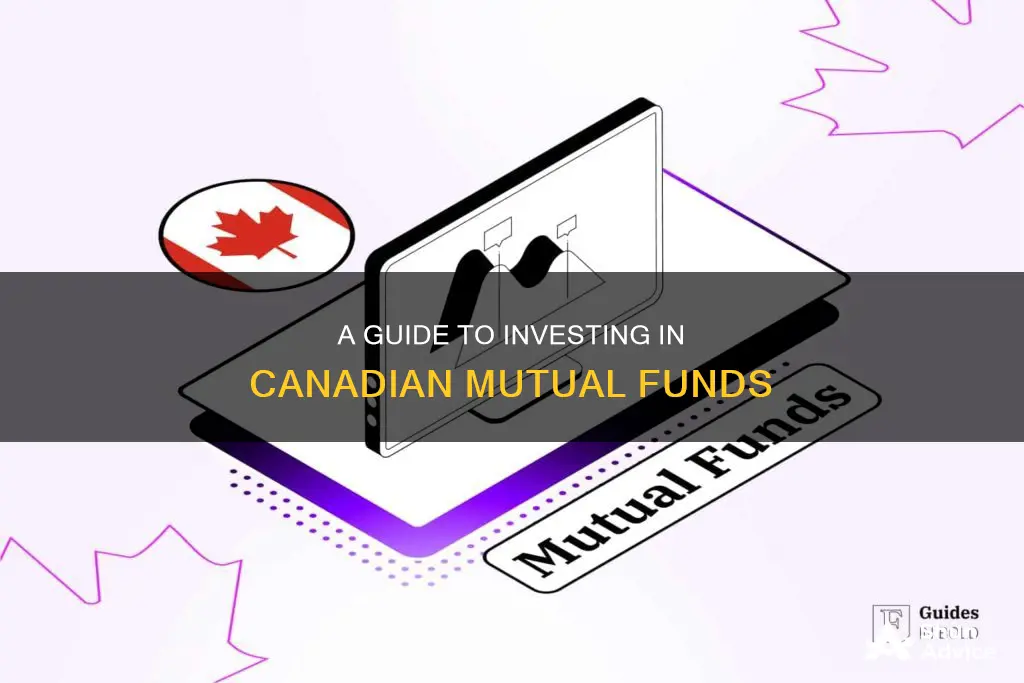
Investing in mutual funds is a great way to diversify your portfolio without the hassle of having to buy and trade individual stocks or bonds. Mutual funds pool money from a set of investors and use it to invest in various asset classes like stocks, bonds, commodities, and alternatives. In Canada, there are over 5,000 mutual funds to choose from, and deciding which one is right for you will depend on your financial goals, risk tolerance, and investment timeline.
1. Determine your financial goals and risk tolerance: Before investing, it's important to have clear financial goals and understand how much risk you're willing to take. Are you investing for the long term, such as retirement, or do you have shorter-term goals? Your risk tolerance will help you choose the right type of fund, such as fixed-income funds for lower risk or equity funds for higher risk and potential growth.
2. Research and compare different mutual funds: There are two main types of mutual funds: actively managed funds, where investment professionals actively trade the fund's holdings, and passively managed funds, which aim to match the performance of a stock index like the S&P 500. Compare the fees and historical performance of similar funds to make an informed decision.
3. Select a reputable investment provider: You can purchase mutual funds directly from mutual fund companies like Fidelity, Vanguard, or BlackRock, or through an online broker or financial advisor. Consider factors such as fees, customer service, and additional services offered when choosing a provider.
4. Understand the fees involved: Mutual funds typically charge various fees, including management expense ratios (MERs), trading fees, and load fees. These fees can eat into your returns over time, so it's important to be aware of them and compare fees between different funds.
5. Monitor and rebalance your portfolio: Once you've invested in mutual funds, it's important to periodically check in on their performance and rebalance your portfolio to maintain your desired asset allocation. This ensures that you stay on track with your financial goals and don't take on more risk than intended.
| Characteristics | Values |
|---|---|
| Number of mutual funds available in Canada | Over 5,000 |
| Types of mutual funds | Actively managed funds, passively managed funds |
| Assets invested in | Stocks, bonds, fixed income securities, money market securities, equities, commodities, alternatives |
| Advantages | Easy diversification, liquid, low minimum investment requirements |
| Disadvantages | High fees, lack of financial advice, not guaranteed fund performance |
| How to invest | Decide how much to invest and for how long, choose the type of fund, shop around to compare fees and performance, choose a financial advisor or mutual fund company, complete the application and buy the funds |
What You'll Learn

Understand the different types of mutual funds
Understanding the different types of mutual funds available is a crucial step in deciding how to invest. Mutual funds can be broadly categorized into two types: actively managed funds and passively managed funds.
Actively managed funds have a portfolio manager who uses research to determine which securities to include in the fund. The goal of an actively managed fund is to outperform a specific index, such as the S&P 500. These funds tend to be more expensive due to the active management and research involved.
On the other hand, passively managed funds are tied to an index, such as the S&P 500 or the Canadian Securities Exchange (CSE). These funds aim to match the performance of the index rather than outperform it. As a result, passive funds are sometimes referred to as index funds. They tend to have lower fees and expenses compared to actively managed funds.
Within these two broad categories, there are several types of mutual funds that cater to different investment goals and risk tolerances. Here are some common types of mutual funds:
- Equity Funds: These are one of the most popular types of mutual funds. Equity funds invest in stocks, including Canadian equities and small or large-cap businesses. They offer the potential for higher returns but also come with higher risks.
- Fixed Income Funds: These funds focus on investments that provide a fixed rate of return, such as government bonds, investment-grade corporate bonds, and high-yield corporate bonds. They are considered lower-risk investments.
- Money Market Funds: Money market funds invest in short-term fixed-income securities, such as treasury bills and high-quality money market instruments. They are typically low-risk and suitable for short-term investment goals.
- Balanced Funds: Balanced funds aim to strike a balance between risk and return. They invest in a mix of stocks and fixed-income securities to provide both growth and income.
- Growth Funds: Growth funds aim for capital appreciation over the long term. They usually invest in a mix of stocks and other growth-oriented securities. Growth funds may have medium to high levels of risk.
- Income Funds: Income funds prioritize current income over capital growth. They invest in dividend-paying stocks, bonds, and other income-generating securities. These funds are suitable for investors seeking regular income.
It's important to remember that different mutual funds carry different levels of risk and potential returns. When choosing a mutual fund, it's essential to consider your financial goals, risk tolerance, and investment horizon. Diversifying your investments across different types of mutual funds can help manage risk and maximize returns.
The Mindset of Investment Fund Managers: Traits and Insights
You may want to see also

Research and compare fees
When it comes to investing in Canadian mutual funds, fees are an important factor to consider. Here are some key points to keep in mind when researching and comparing fees:
- Management Expense Ratio (MER): The MER refers to the fees associated with managing the fund, including costs for fund managers, accountants, marketers, and lawyers. MERs are usually expressed as a percentage of the fund's average net assets, typically ranging from 0.25% to 1.5% per year. Actively managed funds tend to have higher MERs due to the increased research and labour involved.
- Shareholder Fees: These are one-off costs incurred when buying or selling a mutual fund. Examples include exchange fees, redemption fees, account fees, and transaction fees.
- Load Funds vs. No-Load Funds: Load funds charge a sales commission, known as a "load," which can be front-end (paid when purchasing the fund) or back-end (paid when selling your share of the fund). No-load funds, on the other hand, do not charge this sales commission but may still have other shareholder fees.
- Account Minimums: Mutual funds often require a minimum investment amount, which can vary from fund to fund. Be sure to consider this when comparing fees, as some funds may have higher minimums than others.
- Trading Fees: Online platforms often charge a one-time trading fee for purchasing mutual funds, which can be a significant cost, especially for smaller investments.
- Fee Waivers: Some trading platforms may offer fee waivers or discounts for certain mutual funds, so be sure to look out for these opportunities.
- Expense Ratios and Advisory Fees: In addition to MERs, some funds may charge expense ratios or advisory fees, which are similar to management fees but may be structured differently.
When researching Canadian mutual funds, be sure to carefully review the fund's fact sheet, prospectus, and other disclosure documents to understand all the associated fees. Comparing fees is crucial as they can significantly impact your investment returns over time.
Index Funds: Long-Term Investment Strategies Explored
You may want to see also

Decide on your investment strategy
Before you start investing in Canadian mutual funds, it's important to decide on your investment strategy. This will depend on your financial goals, risk tolerance, and investment timeline. Here are some things to consider when formulating your investment strategy:
- Financial goals: Are you investing for the long term, such as for retirement or your child's education? Or do you have shorter-term goals in mind? Knowing your financial goals will help you determine the appropriate investment strategy and types of funds to consider.
- Risk tolerance: How much risk are you willing to take? This will influence the types of funds you choose. If you have a low-risk tolerance, you may prefer fixed-income funds that offer a fixed rate of return. If you're comfortable with higher risk, you might consider equity funds that focus on growth. Balanced funds can provide a moderate approach, aiming to balance risk and return.
- Investment timeline: Your investment horizon will also impact your strategy. For example, if you're in your 20s or 30s, you might allocate a larger portion of your portfolio to stocks, while someone closer to retirement may allocate more to bonds or cash equivalents.
- Types of funds: Familiarize yourself with the different types of mutual funds available, such as actively managed funds and passively managed funds. Actively managed funds have portfolio managers who actively trade the fund's holdings to try to outperform the market. Passively managed funds, or index funds, aim to match the performance of a particular stock index.
- Diversification: Mutual funds offer built-in diversification by investing in a range of assets, such as stocks, bonds, and other securities. However, you can further diversify your portfolio by investing in different types of mutual funds across various sectors and markets.
- Fees and expenses: Mutual funds typically charge various fees, such as management expense ratios (MERs), trading fees, and load fees. These fees can eat into your returns over time, so it's important to understand the cost structure of the funds you're considering.
- Performance: While past performance doesn't guarantee future results, it can give you an idea of how a fund has performed in different market conditions. Compare the performance of similar funds to help you make an informed decision.
Once you've considered these factors, you can start formulating your investment strategy. Decide on the types of funds that align with your goals, risk tolerance, and timeline. Determine how much you want to allocate to each type of fund, creating an asset allocation strategy that suits your needs. Remember to review and rebalance your portfolio periodically to ensure it remains aligned with your investment strategy.
Retirement Fund Strategies: Investing $100K Wisely for Future Security
You may want to see also

Choose a financial advisor or company
Choosing a financial advisor or company is an important step in investing in Canadian mutual funds. Here are some key considerations and steps to help you make an informed decision:
Understand the Role of a Financial Advisor or Company:
Financial advisors are professionals who provide guidance and services related to investments, including mutual funds. They can offer personalised advice, portfolio management, and assistance with investment strategies. Some financial advisors work independently, while others are associated with larger financial institutions. It is important to understand their role and how they can support your investment goals.
Determine Your Needs and Preferences:
Before selecting a financial advisor or company, assess your own needs and preferences. Consider factors such as the level of service you require, your investment goals, and your risk tolerance. Do you prefer a hands-on approach or want someone to manage your investments for you? Thinking about these aspects will help you choose an advisor or company that aligns with your expectations.
Research and Compare Options:
Take the time to research and compare different financial advisors or companies. Look for registered and reputable firms or individuals. Evaluate their qualifications, experience, and specialisations. Compare their service offerings, investment strategies, and fee structures. Reading reviews, testimonials, or seeking referrals from trusted sources can also provide valuable insights.
Understand Compensation and Potential Conflicts of Interest:
It is essential to know how your financial advisor or company will be compensated for their services. Ask about any fees, commissions, or other benefits they may receive for selling specific mutual funds or products. Understanding potential conflicts of interest will help you make an informed decision and ensure that your advisor's recommendations are aligned with your best interests.
Interview Potential Advisors:
If possible, interview multiple financial advisors to find the best fit. Prepare a set of questions to assess their knowledge, experience, and approach to client service. Discuss your investment goals, risk tolerance, and any specific requirements you may have. A good financial advisor should take the time to understand your needs and provide you with clear and concise information.
Evaluate the Level of Service and Support:
Consider the level of service and support you can expect from the financial advisor or company. Assess their responsiveness, accessibility, and willingness to address your questions and concerns. Choose an advisor who makes you feel comfortable, values your input, and provides timely and personalised advice.
Review Disclosure Documents:
Before making a decision, be sure to review relevant disclosure documents. These may include the advisor's or company's brochure, Form ADV (if applicable), or other regulatory filings. These documents can provide valuable information about their investment strategies, fees, potential risks, and any disciplinary history.
Ask for References:
Don't hesitate to ask for references from satisfied clients. Speaking with existing or former clients can give you first-hand insights into the advisor's or company's performance, communication style, and level of service. It can also help you understand how they have helped others in similar situations and whether they were satisfied with the results.
Remember, choosing a financial advisor or company is an important step in investing in Canadian mutual funds. Take the time to do your research, ask questions, and trust your instincts to find a partner who aligns with your investment goals and provides you with the level of service and support you deserve.
Best Vanguard Funds for Your IRA: Top Picks
You may want to see also

Set up a purchase plan
Setting up a purchase plan is an important step in investing in Canadian mutual funds. Here are some detailed instructions to help you set up a purchase plan:
- Determine the frequency and amount of your investments: Decide how often you want to invest and how much you can afford to invest regularly. You may choose to invest a percentage of each paycheck, or opt for a set dollar amount to be invested weekly or monthly. Regular investing offers benefits such as dollar-cost averaging, which helps to reduce the average price you pay per share over time.
- Choose the right investment vehicle: You can purchase mutual funds through various investment accounts, such as a Tax-Free Savings Account (TFSA), Registered Retirement Savings Plans (RRSP), Registered Education Savings Plan (RESP), or Non-Registered Accounts. Consider the tax implications, liquidity, and contribution limits of each account type and choose the one that aligns with your financial goals.
- Select the mutual funds: Decide on the sector you want to invest in. This could include American companies with large market capitalisation, small-cap foreign companies, or emerging markets. Consider your investment goals and risk tolerance when making your selection.
- Compare fees and performance: Research and compare the fees and historical performance of similar mutual funds. Be sure to understand the Management Expense Ratio (MER) and other fees associated with the fund. While past performance does not guarantee future results, it can give you an idea of how the fund has performed in different market conditions.
- Set up automatic investments: To ensure you stick to your purchase plan, consider setting up automatic investments. This can be done through a Pre-Authorised Debit (PAD) or Pre-Authorised Contribution (PAC). This way, you don't have to remember to make your investments manually each time.
- Monitor and adjust as needed: It's important to periodically check in on the performance of your mutual funds. Experts recommend reviewing your asset allocation at least once every six to twelve months to ensure it aligns with your financial goals. Make adjustments as necessary to stay on track.
Mutual Fund Closure: Why Investors Get Shut Out
You may want to see also
Frequently asked questions
There are two basic types of mutual funds: Actively Managed Funds and Passively Managed Funds. Actively Managed Funds have a portfolio manager who uses research to decide which securities to include in the fund. Passively Managed Funds are tied to an index such as the S&P 500 or Canadian Securities Exchange (CSE).
Mutual funds are a great way to diversify your portfolio without the hassle of buying and trading individual stocks or bonds. They are flexible and can react quickly to changing market conditions. They are also liquid, meaning you can buy or sell them once every trading day. However, mutual funds can be costly due to management fees and sales commissions. They may also lack financial advice and there is no guarantee of fund performance.
First, figure out your budget and how much you can afford to invest. Then, decide whether you want an actively or passively managed fund. Next, find a broker who offers the right type of fund for your budget. Make sure you understand all the fees involved, including management expense ratios (MERs) and sales commissions or "loads". Finally, complete the application and make your purchase.







